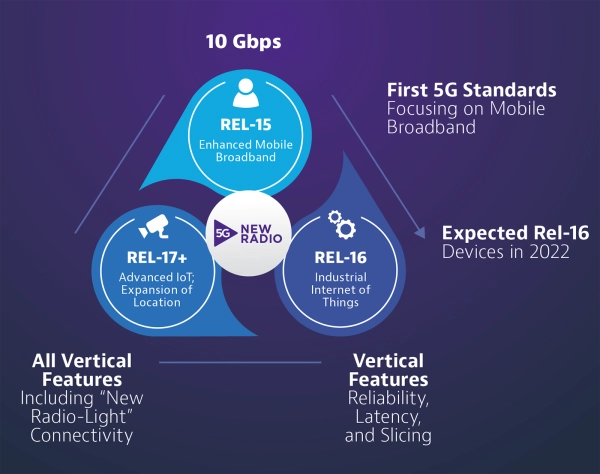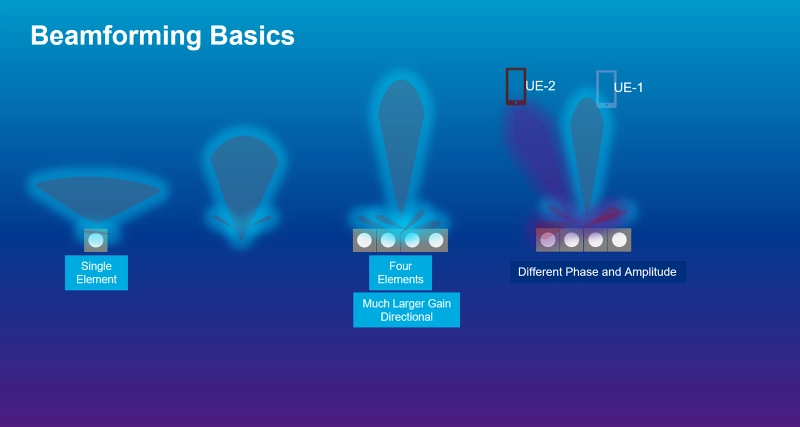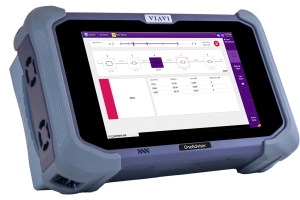5G Network Deployment
Overcome the challenges of 5G network deployment with help from VIAVI.
Breakthrough technologies that are integral to 5G, such as Massive MIMO, network slicing , beamforming and network function virtualization (NFV) require phased approaches to new 5G network deployment. They also require significant investment, with telecom operators expected to spend upwards of $1 trillion on new 5G network deployment over the next decade. This monumental task lends itself to a wide variety of strategies and options, each with inherent benefits and drawbacks surrounding 5G network technology and access to faster speeds.
The promise of new 5G deployment has transitioned from the drawing board to reality. The next generation of wireless technology, planned and developed for nearly a decade, has begun limited service. 5G signal will continue to bring faster speeds, reduced latency, and service improvements. The fundamental architecture that makes this deployment possible is complex and multi-layered.
Start Scaling Your 5G Deployment Today. Download Our Helpful Handbook
5G Deployment Options
Integration of virtualization elements and edge computing, fronthaul, and backhaul network configurations are additional considerations. Small cell placement strategies, MIMO application, and spectrum allocation make each 5G NR installation unique. This level of customization requires scalable, accurate, and efficient test solutions to support the available network deployment models.
Throughout the initial 5G development cycle, operators and industry insiders studied the emerging trends. This led to a collective realization that expedited 5G network deployment service and standardization was necessary. As a result, 45 major players in the LTE wireless industry convened in March of 2017 to create a 5G deployment plan entitled, “Way Forward on the overall 5G-NR eMBB workplan”. This coalition agreed to accelerate 5G adoption by committing to non-standalone (NSA) 5G trials and deployment.

The millimeter wave and Massive MIMO work together in a successful 5G network deployment. While higher frequencies require greater antenna volume, they also allow for a much smaller antenna form factor, due to their shorter wavelength. Deploying and correctly aligning these complex antenna arrays can present challenges.
5G antenna integrators, working at the top of the cell tower, validate the antenna array configuration against the RF planning tool specifications. Failing to complete this validation properly can lead to coverage gaps and service degradation. This is sometimes misinterpreted as an insufficient level of cell site infrastructure, which is an expensive misdiagnosis.
High confidence in 5G antenna deployment is achieved through reliable antenna alignment solutions. The VIAVI 3Z RF Vision Antenna Alignment Tool detects obstructions in the antenna transmission path and verifies correct roll, tilt, and azimuth settings. A built-in camera and augmented reality features can be used to generate automated line of sight surveys and detect unforeseen obstacles in the antenna’s path.
In addition to high frequency operation, the 5G air interface introduces a greater degree of spectrum sharing. Flexible sub-carrier spacing and numerology options are elements of the 5G air interface, along with dynamic time division duplex (TDD). This method uses a single frequency for both uplink and downlink transmission, divided into separate time slots. TDD is similar to traffic control methods that open or close lanes in each direction, based on rush hour demand. Using TDD, uplink and downlink traffic can be intelligently balanced to reduce system latency.
5G air interface innovations can also lead to additional deployment and test challenges. Traditional test practices like gated sweep routines are intended to assess only a single direction of traffic. More visibility is needed to distinguish real signals from interference, especially when TDD has been employed. Innovative VIAVI real-time spectrum analyzers utilize advanced 5G-friendly options. This includes the persistence spectrum and spectrogram features that provide a more detailed view of the monitored frequency band.
The effective combination of massive MIMO, beamforming, and spatial multiplexing allows the 5G coverage to be enhanced. Unique to 5G network deployment, the beamforming technique can be used to focus wireless signals toward a specific receiving device. Combining multiple signals constructively improves bandwidth and coverage. The proper application of beam forming is essential for 5G coverage, particularly in the FR2 band (24.25 – 52.6 GHz). Beamforming also introduces unique challenges for monitoring, maintenance, and validation.

Constructive interference is the scientific principle used improve 5G coverage in the FR2 band by strategically layering signals from each small array. When beam forming infrastructure is deployed, the phase and amplitude of each antenna is optimized to produce a much higher gain directional overall. The 3GPP standards provide flexibility with respect to beam forming policies and SSB location. This lack of standardization can also create to challenges for defining 5G beam forming test practices.
Get the prescription for precise SSB configuration in the VIAVI 5G Beamforming Profile Rx blog post.
Millimeter wave is defined as the spectrum between 30GHz and 300GHz. The low-band spectrum resides below 1GHz. Between these two extremes are the mid-bands, located between 1GHz - 2.6GHz and 3.5GHz - 6GHz. Despite the emphasis on 5G millimeter wave, low and mid-band spectrums are also important to 5G capacity and reliability. The high frequency millimeter wave is prone to distortion and limited in range. With a broad spectrum of frequencies available, this can be addressed through DSS and adaptive beam switching. For example, a UE can be transferred to a more stable, lower frequency as needed until a stable high-frequency connection is established.
The long range and immunity to signal distortion of the low-band spectrum have provided a sturdy foundation for generations of wireless infrastructure. Since low frequency also means slower speeds and higher latency, low-band has found less utility in the age of 5G.
Some have described the 5G mid-band spectrum as the “Goldilocks” spectrum, with a just right compromise between the speed of millimeter wave and the signal integrity and range of low-band frequencies. This is especially true for the C-band frequency range, between 3.7 and 3.98 GHz.
So appealing is the mid-band spectrum for 5G that many operators are “refarming” 3G bands for 5G. In addition, 280 MHz of C-band spectrum was auctioned to the private sector by the FCC in 2020. These transitions help to alleviate the deficit in available mid-band spectrum needed for sustainable 5G deployment.
Five Keys to Successful 5G Deployment
The keys to successful 5G network deployment adapt traditional best practices to the new technological breakthroughs that have set 5G apart. These principles encompass multiple areas of 5G network architecture, technology, and performance.

- Certify all fiber connections and validate orientation/alignment of antenna:
The importance of good fiber hygiene has been magnified by the manifold increase in antenna connections inherent to 5G Massive MIMO. The commitment to high-quality connection and validation must also extend to coax installation for the sub-6 GHz FR1 band. Exceeding the link budget can lead directly to performance degradation and delayed turn-on. Antenna alignment, including both orientation and tilt verification, provides a valuable baseline for optimized 5G cell site performance and coverage. - Verify carrier and SSB spacing frequency, and subcarrier spacing:
The synchronization signaling block (SSB), which is the 5G equivalent of the LTE reference signal, is used to identify and synchronize a cell with specific user equipment (UE). Each SSB can be identified by a unique number known as the SSB index. A UE will latch onto a specific beam, based on the SSB index with the highest observed signal strength. Verifying SSB functionality is critical during 5G network deployment and commissioning. The performance and spacing of each subcarrier should also be tested. - Verify all carriers are present and PCI of each carrier:
A robust 5G network deployment plan should include signal verification for each carrier and their respective physical cell ID (PCI). Carrier aggregation is a technique used to increase the data rate per user by assigning multiple frequency blocks or component carriers to each. Improved utilization through carrier aggregation is an important enabler of 5G bandwidth and use case diversity. - Verify beam IDs for each carrier:In an LTE deployment, coverage can be blanketly characterized by sector. Using 5G NR technology, each individual beam behaves much like a separate coverage area all its own. The “beam-centric” philosophy of 5G highlights the importance of dedicated beam index analysis as part of 5G network deployment.
- Verify 5G site coverage:
Verifying the cell coverage output designed into the 5G network requires accurate 5G coverage mapping to determine beam index, power, and signal-to-noise ratio for a given area. This 5G deployment best practice can be difficult to achieve reliably, particularly for combined 5G and LTE coverage areas. Dynamic Spectrum Sharing (DSS) enables 5G and LTE to operate in tandem for seamless coverage and rapid 5G deployment. The best 5G coverage mapping tools are now provisioned for concurrent LTE and 5G coverage assessment.
5G Deployment Challenges
With so many options to choose from, simply deciding which fifth generation approach to take is the first of many deployment challenges. Breakthrough 5G wireless technology platforms are pushing the envelope of design, manufacturing, and testing capabilities. Network Function Virtualization (NFV) is a prerequisite for core network slicing, intelligence at the edge, and other essential 5G signal features. These technologies enable the IoT and AI-based services. Standardization, security, and delivering the CPU horsepower needed to drive virtual functions are some of the many obstacles being tackled by NFV developers.

The millimeter wave is another essential fifth generation ingredient that can present technological and logistical challenges. Due to the limited range and inability to transmit through solid objects, the sheer volume of antennae required introduces hurdles that can only be addressed through incremental deployment.
Spectral efficiency, measured in (bit/s)/Hz, is currently gated by the Shannon Limit which defines the maximum rate that data can be sent over any medium with zero error. This theoretical ceiling is much less than what is expected and required for 5G deployment. Only Massive MIMO and beamforming, utilizing large antenna arrays, enables 5G to effectively surpass this natural speed limit.
The millimeter wave and Massive MIMO work together in a successful 5G network deployment. While higher frequencies require greater antenna volume, they also allow for a much smaller antenna form factor, due to their shorter wavelength. Deploying and correctly aligning these complex antenna arrays can present challenges.
5G antenna integrators, working at the top of the cell tower, validate the antenna array configuration against the RF planning tool specifications. Failing to complete this validation properly can lead to coverage gaps and service degradation. This is sometimes misinterpreted as an insufficient level of cell site infrastructure, which is an expensive misdiagnosis.
High confidence in 5G antenna deployment is achieved through reliable antenna alignment solutions. The VIAVI 3Z RF Vision Antenna Alignment Tool detects obstructions in the antenna transmission path and verifies correct roll, tilt, and azimuth settings. A built-in camera and augmented reality features can be used to generate automated line of sight surveys and detect unforeseen obstacles in the antenna’s path.
In addition to high frequency operation, the 5G air interface introduces a greater degree of spectrum sharing. Flexible sub-carrier spacing and numerology options are elements of the 5G air interface, along with dynamic time division duplex (TDD). This method uses a single frequency for both uplink and downlink transmission, divided into separate time slots. TDD is similar to traffic control methods that open or close lanes in each direction, based on rush hour demand. Using TDD, uplink and downlink traffic can be intelligently balanced to reduce system latency.
5G air interface innovations can also lead to additional deployment and test challenges. Traditional test practices like gated sweep routines are intended to assess only a single direction of traffic. More visibility is needed to distinguish real signals from interference, especially when TDD has been employed. Innovative VIAVI real-time spectrum analyzers utilize advanced 5G-friendly options. This includes the persistence spectrum and spectrogram features that provide a more detailed view of the monitored frequency band.
The effective combination of massive MIMO, beamforming, and spatial multiplexing allows the 5G coverage to be enhanced. Unique to 5G network deployment, the beamforming technique can be used to focus wireless signals toward a specific receiving device. Combining multiple signals constructively improves bandwidth and coverage. The proper application of beam forming is essential for 5G coverage, particularly in the FR2 band (24.25 – 52.6 GHz). Beamforming also introduces unique challenges for monitoring, maintenance, and validation.

Constructive interference is the scientific principle used improve 5G coverage in the FR2 band by strategically layering signals from each small array. When beam forming infrastructure is deployed, the phase and amplitude of each antenna is optimized to produce a much higher gain directional overall. The 3GPP standards provide flexibility with respect to beam forming policies and SSB location. This lack of standardization can also create to challenges for defining 5G beam forming test practices.
Get the prescription for precise SSB configuration in the VIAVI 5G Beamforming Profile Rx blog post.
Millimeter wave is defined as the spectrum between 30GHz and 300GHz. The low-band spectrum resides below 1GHz. Between these two extremes are the mid-bands, located between 1GHz - 2.6GHz and 3.5GHz - 6GHz. Despite the emphasis on 5G millimeter wave, low and mid-band spectrums are also important to 5G capacity and reliability. The high frequency millimeter wave is prone to distortion and limited in range. With a broad spectrum of frequencies available, this can be addressed through DSS and adaptive beam switching. For example, a UE can be transferred to a more stable, lower frequency as needed until a stable high-frequency connection is established.
The long range and immunity to signal distortion of the low-band spectrum have provided a sturdy foundation for generations of wireless infrastructure. Since low frequency also means slower speeds and higher latency, low-band has found less utility in the age of 5G.
Some have described the 5G mid-band spectrum as the “Goldilocks” spectrum, with a just right compromise between the speed of millimeter wave and the signal integrity and range of low-band frequencies. This is especially true for the C-band frequency range, between 3.7 and 3.98 GHz.
So appealing is the mid-band spectrum for 5G that many operators are “refarming” 3G bands for 5G. In addition, 280 MHz of C-band spectrum was auctioned to the private sector by the FCC in 2020. These transitions help to alleviate the deficit in available mid-band spectrum needed for sustainable 5G deployment.
5G Network Deployment
Unlike past historical transitions in wireless architecture, 5G represents an ongoing evolution of existing networks rather than a wholesale replacement or “forklift” approach. For LTE deployment, the wholesale approach limited financial payback for many operators. Incremental 5G network deployment, with 5G elements layered on top of legacy architecture, is commonly viewed as a prudent way to reduce capital expenditures and minimize financial risk.
The service-based 5G architecture, along with core network slicing technology, enhance existing use cases while enabling new ones. 5G network deployment options are dependent on the business needs and preferences of the operator.
Enhanced mobile broadband (eMBB) will continue to be the biggest global 5G use case in the short term. Operators intending to leverage the large increase in massive machine type communications (mMTC) or ultra-low latency communication (URLLC) are adapting their 5G deployment strategies accordingly. The deployment model also depends on the densification and coverage required for targeted use cases and the allocated spectrum for each network.
5G Commercial Deployment
The number of 5G subscribers is expected to reach 1 billion globally by the end of 2022, with over 1000 commercial 5G devices projected to be available by that time. New 5G network rollouts continue to ramp up around the world, along with the percentage of mobile connections made over 5G. This figure should exceed 50% in North America by 2023. These year-over-year increases are a clear sign of strong competition developing between commercial operators as they strive to enter the 5G marketplace. The completion of Release 17 of the 3GPP 5G specification should accelerate this pace.
Much like the industry-wide collaboration that occurred to standardize 5G architecture, continued cooperation between operators, chipset, and infrastructure manufacturers, device makers, and regulators is needed for successful 5G commercial deployment. With the broad range of 5G service use cases, additional industries such as automotive (including self-driving cars), medical device, agriculture, and aerospace technology are part of the expanding coalition of stakeholders.
A path towards 5G standardization, evolution, and use case diversity has been introduced through Open RAN (O-RAN) architecture. The Open RAN concept is based on the interoperability of 5G RAN elements, including white-box hardware and open source software. Competition, efficiency, and innovation in the 5G new radio space are accelerated through this shift away from the single-vendor RAN model.
The O-RAN ALLIANCE was founded in 2018 by a diverse consortium of operators with the common goal of enabling a more open 5G RAN infrastructure. A guiding principle of the alliance is imbedded intelligence at both the component and network levels. O-RAN compliments 5G deployment by allowing operators to develop disaggregated, multi-vendor solutions. It also lowers the barrier to entry for new 5G NR innovators while reducing time to market (TTM).
An important counterpoint to the expanding 5G commercial footprint is the growing demand for 5G private networks. Referred to as non-public networks (NPN) by 3GPP, a 5G private network is intended for the sole use of a private company or government agency. 5G private networks are essentially the next generation of local area networks (LANs).
With sub 1ms latency, ultra-high throughput, and 99.9999% reliability, 5G private network deployment provides distinct advantages over Ethernet LAN or LTE private networks. These benefits include a tenfold device density improvement over LTE and improved security protocols. Use cases that are well suited to this combination of attributes include smart manufacturing (Industry 4.0), healthcare IoT, and public safety communications.
Deployment of a 5G private network can be completed as a standalone activity or in conjunction with the RAN and Core of a commercial network. Organizations utilizing private 5G networks might pursue one or both options, depending on company size and resources. Many corporate 5G deployments are intended to either replace or bolster existing private WiFi networks.
5G Deployment and Fiber
Wireless technology gets most of the attention when 5G is discussed, but fiber deserves equal consideration. Despite the advancement of IAB technology to use portions of the available mmWave spectrum for backhaul, a high percentage of 5G backhaul will remain fiber-based. Connections between the next generation core (NGC) and NR active antennae are also completed using a fiber pathway.
With the high volume of connections required for 5G fronthaul and midhaul applications, PON architecture is has proven to be a useful option. PON can be easily scaled to meet increased throughput demands. Validation of all fiber and PON connections must be completed, making advanced 5G fiber optic test solutions essential for fiber hygiene during 5G deployment.
Just one dust particle as small as 1 micron can lead to a network installation failure. The radio may not obtain an adequate signal. Other preventable and common installation issues include loose connections, radio fallout, and rolled “fibers” (TX and RX reversed at installation). Each of these problems can lead to “holes” in coverage, poor throughput, and ultimately, dissatisfied customers.
A visual fault locator (VFL) can easily identify trouble spots when signal continuity is lost. Thorough validation of power levels and detailed loss testing using an OTDR can keep 5G cell cite integration on track by addressing and resolving 5G fiber installation issues quickly.

5G Deployment Tools
5G has transformed all elements of wireless network infrastructure. This includes fiber, RAN, transport, and asset management. Each phase of 5G NR deployment now requires a specialized tool kit to support implementation. Operators have developed their own individual Method of Procedure (MOP). The more comprehensive approach to fiber testing, OTA verification, beam analysis, coverage, and throughput testing is often the more successful; just a single underperforming cell site can delay the launch of an entire large-scale deployment.
During the verification and validation phase for new 5G network equipment, test solutions capable of simulating 5G core and real-world user behavior in the lab can help to establish 3GPP conformance and quality of service prior to activation of 5G signals. The TM500 network tester can assess the complete 5G network user experience. This includes simulated interactions with other users and typical real-world device behavior such as emailing and streaming in the mobile world. The TM500 also supports a high number of UE’s per cell or carrier to evaluate capacity.
During the technology deployment, activation and scaling phase, the spectrum and interference of 5G signals in the millimeter wave requires accurate and reliable RF characterization and conformance testing. The portable OneAdvisor 800 combines real-time spectrum and interference analysis with 5G beam analysis capabilities. This makes it an optimal solution for massive MIMO and antenna beam validation. The OneAdvisor 800 also includes built-in fiber test and inspection capabilities for added 5G deployment versatility.

The importance of testing continues throughout the assurance, optimization, and monetization phase. In this phase, Quality of Experience (QoE) becomes a primary concern for fully operational networks. Advanced applications such as the IoT and autonomous vehicles have created enticing monetization opportunities with very low margin for error. This makes scalable, real-time intelligence platforms such as NITRO Mobile essential for capturing, locating, and analyzing mobile events for exceptional user experience insights.

This historic distinction bestowed upon 5G adoption has spearheaded a massive infrastructure evolution and paradigm shift. Key players in this transformation have included many of the best engineers and scientists in the world. Infrastructure experts have realized that the wide array of new use cases require both standardization and flexibility, which can be difficult to achieve at the same time. Adherence to emerging infrastructure specifications and functional versatility make the very best 5G test tools essential components of the evolving 5G deployment landscape.
Successfully Deploy 5G With Help From VIAVI today!
Are you ready to take the next step with one of our 5G service deployment products or solutions?
Complete one of the following forms to get going:
Let Us Help
We’re here to help you get ahead.




